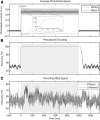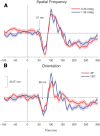Feature-specific information processing precedes concerted activation in human visual cortex
- PMID: 23637162
- PMCID: PMC6618946
- DOI: 10.1523/JNEUROSCI.3905-12.2013
Feature-specific information processing precedes concerted activation in human visual cortex
Abstract
Current knowledge about the precise timing of visual input to the cortex relies largely on spike timings in monkeys and evoked-response latencies in humans. However, quantifying the activation onset does not unambiguously describe the timing of stimulus-feature-specific information processing. Here, we investigated the information content of the early human visual cortical activity by decoding low-level visual features from single-trial magnetoencephalographic (MEG) responses. MEG was measured from nine healthy subjects as they viewed annular sinusoidal gratings (spanning the visual field from 2 to 10° for a duration of 1 s), characterized by spatial frequency (0.33 cycles/degree or 1.33 cycles/degree) and orientation (45° or 135°); gratings were either static or rotated clockwise or anticlockwise from 0 to 180°. Time-resolved classifiers using a 20 ms moving window exceeded chance level at 51 ms (the later edge of the window) for spatial frequency, 65 ms for orientation, and 98 ms for rotation direction. Decoding accuracies of spatial frequency and orientation peaked at 70 and 90 ms, respectively, coinciding with the peaks of the onset evoked responses. Within-subject time-insensitive pattern classifiers decoded spatial frequency and orientation simultaneously (mean accuracy 64%, chance 25%) and rotation direction (mean 82%, chance 50%). Classifiers trained on data from other subjects decoded the spatial frequency (73%), but not the orientation, nor the rotation direction. Our results indicate that unaveraged brain responses contain decodable information about low-level visual features already at the time of the earliest cortical evoked responses, and that representations of spatial frequency are highly robust across individuals.
Figures






Similar articles
-
Edge-Related Activity Is Not Necessary to Explain Orientation Decoding in Human Visual Cortex.J Neurosci. 2017 Feb 1;37(5):1187-1196. doi: 10.1523/JNEUROSCI.2690-16.2016. Epub 2016 Dec 21. J Neurosci. 2017. PMID: 28003346 Free PMC article.
-
Decoding the orientation of contrast edges from MEG evoked and induced responses.Neuroimage. 2018 Oct 15;180(Pt A):267-279. doi: 10.1016/j.neuroimage.2017.07.022. Epub 2017 Jul 13. Neuroimage. 2018. PMID: 28712993
-
The temporal frequency tuning of human visual cortex investigated using synthetic aperture magnetometry.Neuroimage. 2004 Apr;21(4):1542-53. doi: 10.1016/j.neuroimage.2003.10.045. Neuroimage. 2004. PMID: 15050578
-
Spatial phase and the temporal structure of the response to gratings in V1.J Neurophysiol. 1998 Aug;80(2):554-71. doi: 10.1152/jn.1998.80.2.554. J Neurophysiol. 1998. PMID: 9705450
-
Cortical cartography revisited: A frequency perspective on the functional architecture of visual cortex.Prog Brain Res. 2006;154:121-34. doi: 10.1016/S0079-6123(06)54006-3. Prog Brain Res. 2006. PMID: 17010706 Review.
Cited by
-
Decoding N400m Evoked Component: A Tutorial on Multivariate Pattern Analysis for OP-MEG Data.Bioengineering (Basel). 2024 Jun 13;11(6):609. doi: 10.3390/bioengineering11060609. Bioengineering (Basel). 2024. PMID: 38927845 Free PMC article.
-
A Reproducible MEG/EEG Group Study With the MNE Software: Recommendations, Quality Assessments, and Good Practices.Front Neurosci. 2018 Aug 6;12:530. doi: 10.3389/fnins.2018.00530. eCollection 2018. Front Neurosci. 2018. PMID: 30127712 Free PMC article.
-
Real-world structure facilitates the rapid emergence of scene category information in visual brain signals.J Neurophysiol. 2020 Jul 1;124(1):145-151. doi: 10.1152/jn.00164.2020. Epub 2020 Jun 10. J Neurophysiol. 2020. PMID: 32519577 Free PMC article.
-
Discriminating orientation information with phase consistency in alpha and low-gamma frequency bands: an EEG study.Sci Rep. 2024 May 25;14(1):12007. doi: 10.1038/s41598-024-62934-y. Sci Rep. 2024. PMID: 38796618 Free PMC article.
-
Decoding Rich Spatial Information with High Temporal Resolution.Trends Cogn Sci. 2015 Nov;19(11):636-638. doi: 10.1016/j.tics.2015.08.016. Epub 2015 Oct 1. Trends Cogn Sci. 2015. PMID: 26440122 Free PMC article.
References
-
- Chalupa LM, Werner JS. The visual neurosciences. Cambridge, MA: MIT; 2003.
Publication types
MeSH terms
LinkOut - more resources
Full Text Sources
Other Literature Sources
